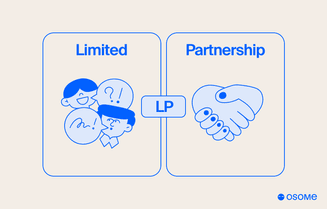Limited Partnership: Structure, Benefits, and Key Considerations
- Modified: 21 November 2024
- 8 min read
- Starting a Company


Heather Cameron
Author
From expert guidance and helpful accounting tips to insights on the latest trends in fintech, Heather is here to empower entrepreneurs and small business owners in Singapore with great content. With a background in digital marketing spanning eight years, she has experience writing for various industries and audiences. As Osome’s copywriter, she’s here to inform and inspire our readers with great storytelling.

Nisah Rahim
Reviewer
Nisah Rahim is our go-to expert reviewer for all things Corporate Secretary-related in Singapore. As the Corporate Secretary Team Lead and content reviewer, Nisah meticulously examines our blog posts to ensure we provide comprehensive information on Corporate Secretary services such as local regulatory compliance, managing board meetings, maintaining company records, and providing expert advice on corporate governance matters.

Imran Marican
Reviewer
Imran Marican, ATA SCTP member, is our Corporate Tax Assistant Manager based in Singapore, with almost a decade of experience in Singapore corporate tax. With in-depth knowledge of Singapore corporate tax law and regulations, he can help with corporate tax compliance that matters to every company. While our business writers transform complicated tax jargon into easy-to-understand concepts, as a reviewer for the Osome blog, Imran ensures our content is accurate and relevant, helping our readers boost their businesses with helpful tips and insights.
A limited partnership (LP) involves general partners who manage the business with unlimited liability and at least one limited partner who invests with liability limited to their investment. This article explores its structure, key benefits, roles, partnership obligations, comparisons with other business structures, and LP registration process.
Key Takeaways
- A limited partnership (LP) consists of a general partner with unlimited liability and a limited partner whose liability is restricted to their investment, providing a flexible structure for various venture capital investments or other ventures.
- The partnership agreement is critical in defining the roles, responsibilities, and operational guidelines for the partners, helping to prevent disputes and ensuring clarity.
- Limited partnerships offer advantages like pass-through entities taxation and liability protection for limited partners, but also present challenges such as the general partner’s limitless liability and complexities in attempts to transfer ownership interests.
What Is a Limited Partnership?
A limited partnership involves at least one partner serving as a general partner as well as at least one limited partner. The general partnership structure means the general partner handles day-to-day operations and assumes limitless liability, while limited partners contribute capital with liability limited to their investment. This combination of active management and passive investment makes LP registration versatile for various business scenarios.
If you're considering setting up a limited partnership, Osome can help you streamline the incorporation process, ensuring compliance and allowing you to focus on growing your business.
Features of a Limited Partnership
Limited partnerships (LPs) are distinctive for having a general partner who manages operations and assumes unlimited liability, while limited partners provide capital without engaging in daily management, enjoying liability protection up to their investment. This division of roles combines managerial expertise with financial backing, making it attractive for venture capital and other investment-based ventures.
Another key feature is pass-through entities taxation, with the partnership’s income reported on individual partners’ tax returns for tax purposes.
However, transferring ownership interests can be complex and usually requires the consent of the other partner or partners, particularly in situations where a limited partner seeks to transfer their interest.

Roles within a Limited Partnership
In a limited partnership (LP), general partners manage the business and have limitless liability, while at least one limited partner contributes capital and enjoys limited liability.
General partner responsibilities
General partners manage daily operations and make strategic decisions, binding the partnership in contracts and handling overall administration. Their active role is essential for steering the business owned by the LP towards its goals and ensuring smooth operation.
However, general partners hold unlimited liability, meaning their personal assets can be used to satisfy debts if the business’s assets are insufficient. This risk underscores the need for careful strategic planning, especially in sectors such as venture capital where large sums of capital are involved.
Limited partner responsibilities
Limited partners are passive investors with liability confined to their investments. To maintain limited liability status, a limited partner must refrain from business activities, benefiting from the partnership’s profits without risking personal assets beyond their initial contribution.
If a limited partner takes an active role in managing the business, they risk losing their limited liability protection and can be held liable for business debts. Therefore, limited partners must understand and adhere to their passive role to safeguard their financial interests and ensure they remain legally protected within the legal entities structure.
How To Start a Limited Partnership?
Starting a limited partnership begins with drafting a comprehensive partnership agreement outlining the business activity, partner contributions, profit distribution, management structure, and dissolution terms. This document ensures all other partners are aligned in their roles and expectations.
Next, register the limited partnership with the local authorities, typically the office of the local secretary of state. This process often requires proof of identity, a residential address, a registered business address, and compliance with local regulations, ensuring legitimate and smooth operation.
Partnership Agreement Essentials
A well-crafted partnership agreement is the cornerstone of a successful limited partnership. It should clearly define contributions, responsibilities, and profit-sharing arrangements among partners, serving as a binding contract that outlines the operational framework and helps prevent future disputes. Seeking professional advice during the drafting of this document can also ensure that the agreement complies with legal requirements and safeguards the interests of all parties involved.
Key elements of a partnership agreement include the business purpose, roles and responsibilities of each partner, profit and loss allocation, terms of admission for new partners, and procedures for dispute resolution and dissolution. It’s also essential to ensure that partnership interests are clearly outlined in the agreement, addressing ownership percentages and rights in the event of dissolution. Addressing these areas ensures all partners are aligned, fostering a transparent and cooperative business environment.

Advantages of Limited Partnerships
Limited partnerships offer several advantages, including simplicity and cost-effectiveness of formation and maintenance compared to corporations. This appeal makes LPs particularly attractive for small businesses and ventures seeking a straightforward setup.
Limited partnerships also provide liability protection for limited partners, shielding their personal assets from the partnership’s obligations. This feature benefits investors looking to pool capital while minimising personal financial risk.
Seeking professional advice during the setup of the partnership can further enhance the operational structure and ensure long-term success.
Disadvantages of Limited Partnerships
Despite their benefits, limited partnerships have notable disadvantages. General partners face unlimited personal liability, meaning their assets can cover the partnership’s debts and legal issues. This significant risk requires careful consideration and thorough financial planning.
Limited partners risk losing their liability protection if they engage in active management, limiting their involvement and influence within the partnership. Additionally, they could be held personally liable if their role extends beyond passive investment, undermining the limited liability status they initially benefit from.
Taxation of Limited Partnerships
Limited partnerships benefit from pass-through taxation, meaning the partnership itself is not subject to income tax. Income and losses are transferred to individual partners and reported on their personal tax returns. This approach can provide tax advantages by avoiding the double taxation faced by corporations. Additionally, self-employment taxes may apply to general partners based on their share of the partnership's income.
Each partner’s share of the partnership’s income is taxed at their individual income tax rates. Limited partnerships must file annual income tax returns via the IRAS tax portal, reporting the partnership’s income, deductions, and other financial information. Accounting firms are often employed to ensure compliance and accuracy in filing these financial statements.
Comparing Business Structures
Choosing the right business structure is crucial for any entrepreneur or investor. Limited partnerships, general partnerships, limited liability companies (LLCs), limited liability partnerships (LLPs), and other types of corporations each offer distinct advantages and drawbacks, including the benefit of being a separate business entity.
For instance, limited liability partnerships (LLPs) protect all other partners from personal liability for the partnership's obligations, while general partners in a general partnership are held liable for debts. In contrast, corporate shareholders enjoy complete liability protection in a corporation.
LP vs. LLC
Limited partnerships and limited liability companies differ significantly in business structures and liability protections. In a limited liability company, all LLC members enjoy personal liability protection and can participate in managing the company, offering a more flexible structure. Conversely, in a limited partnership, only limited partners have liability protection, while the general partner and one or more limited partners contribute to the business. The general partner bears limitless liability and manages the business.
The tax treatment also varies, with LLCs often providing more favourable options for business owners. Understanding these differences is crucial for choosing the right structure based on the business’s specific needs and goals.

LP vs. LLP
Limited partnerships and limited liability partnerships differ in liability and management. In an LP, general partners have limitless liability, while limited partners enjoy liability protection but cannot engage in management. In contrast, all LLP partners have limited liability, and there are no general partners.
The choice between an LP and an LLP often depends on the desired structure and risk tolerance of the partners. Each structure serves different purposes and offers unique benefits and challenges.
LP vs. Pte Ltd
Comparing limited partnerships to Private Limited Companies (Pte Ltd) reveals significant differences in flexibility and liability protections. LPs offer a more flexible structure with easier management and operation, while Pte Ltds provide robust liability protections and are favoured for their tax benefits.
The cost of setting up and maintaining these structures also differs, with Pte Ltds generally incurring higher initial and ongoing costs. Choosing between these structures requires careful consideration of the business’s needs and the regulatory environment.
Limited Partnerships Examples
Limited partnerships are widely used in various industries, particularly for investment purposes. They are common in real estate projects, hedge funds, venture capital, and other investment funds, where pooling resources is essential. The corporation structure allows investors to benefit from collective capital while minimising individual risk.
Master Limited Partnerships (MLPs), often found in the oil and gas industry and publicly traded, are another example. These practical applications demonstrate the versatility and effectiveness of limited partnerships in different scenarios, attracting VC firms/venture capital funds and institutional investors for larger ventures.
Key Considerations for Potential Partners
Before committing to a limited partnership, potential partners must evaluate their long-term financial goals and risk tolerance. Understanding the implications of their roles and the partnership structure is crucial for making informed decisions.
Summary
In conclusion, limited partnerships offer a blend of management and investment benefits that can suit various business needs. Understanding the structure, roles, and tax implications is essential for leveraging the advantages while mitigating the risks.
At Osome, we specialise in helping businesses navigate these complexities with ease. Our expert team is here to assist you in registering your partnership to ensure compliance and maximise benefits. Let Osome handle the details so you can focus on growing your business.






